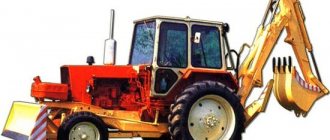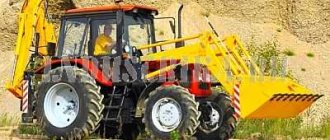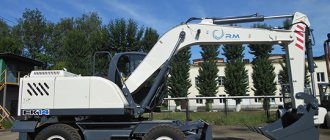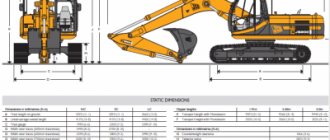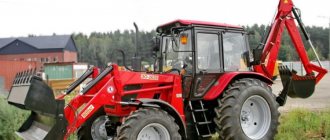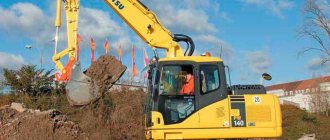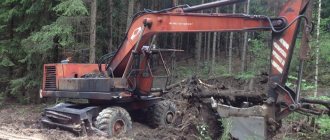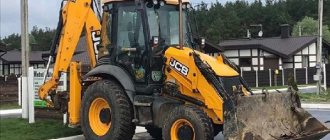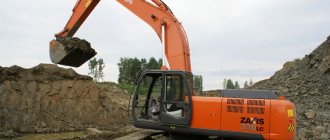The Kostroma Excavator Plant (now JSC Eksko) modernized the E-10011E serial universal crawler excavator in order to increase reliability, durability and improve the machine’s performance. In 1982, a prototype of the modernized EO-5111B excavator passed acceptance tests and was recommended for mass production. The EO-5111B excavator is designed to perform excavation work in soils of categories I - IV and finely crushed rocks, loading and unloading and installation work in industrial and civil construction at air temperatures from -40 to +40°C. The excavator consists of a running multi-support tracked device, a rotating platform with mechanisms, a body and a driver’s cabin and interchangeable working equipment: a front and back shovel, a dragline, a grab and a crane.
Technical characteristics of the EO-5111B excavator
Engine power, kW
| 79,5 | |
| Travel speed, km/h | 2 |
| Operating air pressure in the pneumatic control system, MPa | 0,5 |
| Turntable rotation speed, rpm | 7,15 |
| Ground pressure, MPa | 0,09 |
| Overall dimensions (without working equipment), mm: | |
| length | 5490 |
| width | 3100 |
| height (without spotlights) | 3420 |
| Weight with backhoe, t | 32,4 |
Diesel engines D-108-3, D-108-8 or D-160-B with a torque converter with an extended service life can be used as a power plant for the excavator. To optimize the thermal regime of the torque converter, the capacity of the hydraulic system was increased and cooling radiators were connected in series. To increase the durability of the chain transmission, the gearbox uses a device with separate tension of the chain branches. The track rollers and support rollers feature pocket axles with increased lubrication and improved seals. Track drive chains have high breaking strength for reliable operation in harsh operating conditions. In the working equipment, the cross beam of the two-legged stand, the cage of the bucket block, the head blocks of the boom, the body of the dragline bucket, and the metal structure of the backhoe boom are reinforced. In the manufacture of working equipment, the use of high-strength low-alloy steels has been expanded. Compared to the E-10011E, the modernized EO-5111B excavator has a more comfortable cabin lined with panels with noise-absorbing material. The visibility of the working area has been improved: the front glass has no jumper, the top glass has become larger and without bends. The front glass of the cab is equipped with a windshield wiper and a sun visor. The tightness of the cabin has been improved due to the introduction of seals and special casings in the control panel openings. At the joints of the cabin with the turntable, a rubber gasket is installed along the entire perimeter, which serves as a seal and vibration isolator for the cabin. The cabin floor is covered with a layer of corrugated rubber. The cab is equipped with a two-column control panel with a force on the handles of less than 30 N, a more compact instrument panel and a unified seat, adjustable depending on the driver’s height. The cabin is equipped with a heater and fan. The design and technological improvements made on the modernized EO-5111B excavator made it possible to reduce the labor intensity of maintenance, increase the reliability and durability of machine components as a whole, improve the operator’s working conditions and ultimately increase productivity by 15%. The EO-5111B excavator was awarded the State Quality Mark.
| Cabin of excavator EO-5111B |
straight shovel
| Bucket capacity, m3: | |
| for soils of category IV | 1 |
| for soils of categories I-III | 1,2 |
| Maximum digging radius, m | 9,2 |
| Maximum unloading height, m | 6 |
| Maximum digging force, kN | 155 |
| Length of the planned site at the parking level, m | 2,8 |
| Operating cycle duration, s | 17 |
Backhoe
| Bucket capacity, m3: | |
| for soils of category IV | 1 |
| for soils of categories I-III | 1,2 |
| Maximum digging depth, m | 6,9 |
| Maximum digging radius at parking level, m | 10,5 |
| Height of unloading into transport, m | 4,2 |
| Maximum digging force, kN | 155 |
| Operating cycle duration, s | 23 |
Dragline
| Bucket capacity, m3: | ||
| for soils of category IV | 1 | |
| for soils of categories I-III | 1,2 | |
| Boom length, m | 12,5 | 15 |
| Boom angle, degrees | 45 | 45 |
| Maximum digging radius, m | 12 | 14 |
| Maximum unloading radius, m | 10,2 | 12 |
| Maximum unloading height, m | 6,6 | 8,4 |
| Depth at end passage, m | 7,4 | 9,2 |
Grab
| Bucket capacity, m3: | 1 | |
| Boom length, m | 12,5 | 15 |
| Boom angle, degrees | 45 | 45 |
| Reach from the axis of rotation, m | 10,2 | 12 |
| Maximum unloading height, m | 6,9 | 8,7 |
| Maximum scooping depth, m | 3,3 | 6 |
| Width of open bucket jaws, m | 2,4 |
Tap
| Maximum lifting capacity with a boom length of 12.5 m, t | 16 |
| Maximum lifting height of the hook with a boom length of 25 m, with a jib, m | 25 |
| Length of used arrows, m | 12,5; 15; 17,5; 20; 22,5; 25 |
You can get acquainted with a detailed description of the kinematic diagram, control and reeving of excavator ropes on the technical page. descriptions of the EO-5115 , modernized EO-5111B on a tractor-type crawler.
Excavator EO 5111 technical characteristics
Excavator EO-5111 Dragline cable (cable) Kostroma Excavator Plant.
Used Excavator EO-5111B for sale Year of manufacture -1988 Bucket volume - 1.25 cubic meters. Boom length - 12.5 m.
Engine D160B-6, power 140 hp. Completeness 99% Support roller missing. 1 track requires tension. All cables are in place and in good condition. Located in a parking lot in the Kyiv region. Price – 110,000 UAH.
Technical characteristics Excavator EO5111 Cable dragline (cable) of the Kostroma Excavator Plant Weight - 32 tons. Bucket volume - 1.25 cubic meters. Boom length - 12.5 m. Max. digging depth with a boom of 12.5 m is 10 m. The largest digging radius is with a boom of 12.5 m - 13.5 m,
General description of the model:
Excavator EO-5111B The universal full-rotating single-bucket cable crawler excavator EO-5111B is designed for excavation work in soils of categories I - IV and finely crushed rocks, loading and unloading and installation work in industrial and civil construction at air temperatures from -40 to + 40°C. The excavator consists of a running multi-support tracked device, a rotating platform with mechanisms, a body and a driver’s cabin and interchangeable working equipment: a front and back shovel, a dragline, a grab and a crane.
The predecessor of the EO-5111 excavator, the EO-10011 excavator, at the time of production and its peak of popularity, had the most effective indicators, this was superiority in both domestic and foreign excavator construction. In addition, the design of the excavator turned out to be so successful that it was produced with minor modifications until the 90s of the 20th century; this model became the base in the production of such models as the EO-5111, EO-5116 excavator, as well as their prototypes for working in difficult conditions North.
EO-5111 AS excavator for work in the North - produced by the Kostroma Excavator Plant, bucket capacity 1 cubic meter. EO-5111 was developed on the basis of the E-10011A excavator and has a common kinematic diagram with it, as well as the design of the main components and slightly changed technical characteristics. The shape and design of the cabin was modernized, the front glass became with a negative slope, the EO-5111 AS, thanks to its design features, made it possible to be ready for launch when working in the North and reduce downtime due to technical problems. EO-5111 was produced starting in 1968, and further modification mainly affected not the design of the excavator, but mainly its name. EO-5111 received a new name E-10011 EHL, retaining all the basic elements of E-10011. In the early 80s, mechanical excavators EO-5111B were produced at the Kostroma Excavator Plant, they replaced the E-10011E excavator. This model was already intended for excavation work in category I - IV soils and finely crushed rocks, loading and unloading and installation work in industrial and civil construction at air temperatures from -40 to +40 ° C. The EO-5111 used diesel engines D-108-3, D-108-8 or D-160-B with a torque converter, with an increased service life.
Due to a fairly successful and efficient design and a long production period - more than 10 years, EO-5111 B excavators are still in use today.
The EO-5111B excavator has a hydrodynamic drive, in which a torque converter is installed between the diesel engine and the transmission, ensuring good operation of the machine. The excavator is equipped with: a front and back shovel, a dragline, a crane, and a grab. On cable excavators, the mechanisms are activated using friction clutches, and the clutches and brakes are controlled through a pneumatic system.
Draglines are used when developing soil below the excavator parking level.
The digging depth, height of unloading of the bucket and the distance over which the bucket (digging radius) of a dragline can be thrown are significantly greater than those of forward and reverse shovels. Therefore, draglines are used for digging relatively large pits and trenches, as well as for filling embankments, for example, in the construction of canals, roads and railways.
The design allows for free release (dumping) of the cargo rope; the excavator can be easily converted into a demolition machine (replacing the bucket with an impact load) or a rammer (replacing the bucket with a rammer load).
Thus, with the help of one excavator it is possible to carry out such technological operations as grinding frozen (or rocky) soil, removing soil and compacting developed soil (pit, trench).
The EO-5111B excavator has a hydrodynamic drive, in which a torque converter is installed between the diesel engine and the transmission, ensuring good operation of the machine. The excavator is equipped with: a front and back shovel, a dragline, a crane, and a grab. On cable excavators, the mechanisms are activated using friction clutches, and the clutches and brakes are controlled through a pneumatic system. The main technical characteristics of single-bucket rope excavators are given in the table.
Crawler excavator of the 5th size group EO-5111B with a hydrodynamic drive and “straight shovel” equipment Excavators with a straight shovel are designed for excavating soil above the level of their parking lot.
The “straight shovel” equipment consists of: a bucket, a handle, a boom, a saddle bearing. The bucket is rigidly fixed to the handle. The handle is connected to the boom by a saddle bearing, which allows the handle not only to rotate in a vertical plane, but also to perform reciprocating movements. The boom is suspended on a boom rope. Depending on the height of the face, the boom can be raised or lowered using a boom winch. During operation, the boom is installed at an angle of 45 and 60°. The handles of straight shovels are single-beam (internal type) and double-beam (external type). The handle, covered by a saddle hinged on the boom, can perform a reciprocating movement in the guides, as well as rotate in a vertical plane. The design of the pressure mechanism depends on the design of the handle.
So, with a single-beam handle, a rope pressure mechanism is used, and with a double-beam handle, a ratchet mechanism is used. With a backhoe, the soil is excavated below the excavator parking level.
The backhoe bucket is rigidly mounted on a handle, which is hinged to the upper end of the boom. The handle can rotate when one (traction or lifting) rope is tensioned while the second one is loosened. The angle of inclination of the boom continuously changes during operation: when the traction rope is braked, the boom rises while winding the hoisting rope onto the winch drum and lowers when the drum is released. The lifting rope is supported by blocks of a fixed additional stand. In this case, arrows are used from a straight shovel. A shock absorber is mounted on the upper side of the boom, protecting it from impacts of the handle when throwing the bucket forward during unloading or when sharply lowering it to the ground. The front leg serves to increase the angle between the hoisting rope and the boom, which reduces the load on the boom, as well as wear on the rope. Blocks mounted on the front post allow the boom to be lowered quite low.
Scheme of operation of a backhoe: The stand is a portal, ball-and-socket mounted in the eyes of the rotating frame. In its upper part there are mounted blocks of a lifting pulley and blocks for raising and lowering the front pillar.
The dragline includes a bucket/with suspension, boom, traction, lifting and boom ropes, boom suspension ropes and traction rope guidance. The boom is welded and has a lattice structure, which makes it possible to reduce its weight and make it longer. As a result, the machine's operating range and unloading height increase. The boom consists of two parts, the lower of which is widened towards the boom heel and hinged in the eyes of the turntable.
The length of the boom can be increased with additional inserts. With such an extension of the boom, a smaller volume bucket is used. When working with a dragline, the boom angle is usually 30-45°.
In order not to replace the boom rope, the length of which is designed for the boom of a straight shovel, additional boom suspension ropes are used to suspend the dragline boom, connecting the axis of the boom head blocks with the movable crossbeam. In this case, depending on the length of the boom, the boom rope is stored according to one of the schemes - six branches and four branches.
general scheme; diagram of reeving the boom rope when suspending the boom on six branches; the same, on four branches; ladle; traction rope; installation of the traction rope; jib rope; movable traverse; boom suspension ropes; lifting rope; arrow; head, block; connecting link; traction chain; lugs; bucket arch; unloading rope; tipping block lifting chains; spacer
The dragline bucket is hinged to two lifting chains, which are pinned to lugs located towards the rear of the bucket and welded to its side walls. The upper ends of the chain are fixed to the cage of the tipping block, to which the lifting rope is attached. If you loosen the traction rope, the bucket will tip down with its teeth, turning on the fingers of the eyes, and hang on the chains. To allow the bucket to rotate freely when tipping, the lifting chains are spread apart by a spacer. With the simultaneous tension of the lifting and traction ropes, the distance between the connecting link and the tipping block increases, which is accompanied by the tension of the unloading rope, fixed at one end to the link and the other to the eye of the arch.
When developing light soils, the loops are installed in the upper position, and in dense soils - in the lower position. When mining the bottom of a deep mine, it is recommended to install the loops in the upper position.
On draglines, in addition to buckets with a straight cutting edge, buckets of increased volume are used without teeth or with two teeth, with a semicircular bottom and a cutting edge. Using such buckets is not always effective, especially when careful planning of the bottom of pits and trenches is necessary.
The grab can be used to develop soils both below and above the excavator parking level, as well as for loading and unloading bulk materials, digging deep pits, and cleaning ponds and canals. Grabs are available in single-rope and double-rope types. The former are less efficient, since to unload they need to be lowered to the ground, which sharply reduces productivity. To equip the grab, a lattice dragline boom is used. It is impossible to develop dense soils with a grab bucket, since its mass is insufficient. In this regard, light, medium and heavy types of buckets are manufactured for the development of soils of various densities. The mass of the bucket should be greater, the denser the soil. However, the heavier the bucket, the less soil it can lift and, therefore, the lower the excavator's performance.
Crane equipment is used during loading and unloading operations. During installation, it is rarely used, since the excavator mechanisms do not provide a wide range of speeds for the crane’s working movements (lifting, turning, lowering the load).

